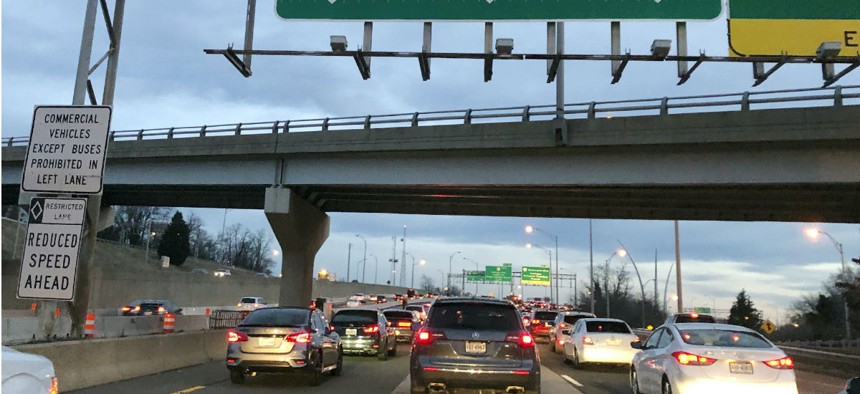
Federal employees returned to work early Monday morning on I-395 in Virginia. Wayne Partlow/AP
It’s Back to Work, But Not Back to Normal
It will be very difficult for federal employees to pick up where they left off, especially with another possible shutdown looming on Feb. 15.
It isn’t over yet.
After the 35-day partial government shutdown, 800,000 federal employees are now returning to paid work and soon they will receive back pay checks. But it will be very difficult for them to pick up where they left off. The fear, anger, and uncertainty over the past shutdown is replaced with the fear, anger, and uncertainty over another potential shutdown in three weeks.
For 35 days, federal employees woke up in the morning wondering if they would be able to pay their bills, and for many, buy food. They suffered the humiliation of asking for help, despite holding good jobs they had worked hard to get and hard to keep it.
They feared President Trump might be right when he said the shut down might last “for months.”
They heard the taunts: “Why are they complaining, they’re going to get all their pay back?” “It’s just a vacation for them.” “Why don’t they just get a loan?” “We don’t need them anyway.”
The felt helpless as hostages taken in a fight that had nothing to do with them, their frustration exacerbated by unsympathetic comments from administration officials and some members of Congress.
Federal employees take pride in their belief that they serve the American public and are involved in something larger than themselves. Many will now question that premise, and we, the American public, will pay the price.
We also will pay a steep financial price for this travesty: The shutdown burned through $90 million a day in accrued costs of back pay for more than 300,000 furloughed workers. That’s $3 billion taxpayers will have spent paying employees to stay home from work.
There also are the incalculable costs to the public of lost public service. Closed Social Security offices, late tax refunds, long airport security lines and delayed flights, harm to our public lands.
The costs will not stop mounting when federal employees return to work. The frustration over lost work hours and the anger generated by the cavalier treatment employees received from some leaders will be on the minds of those returning to work.
Many workers will be focused on determining how much money they’ll need to save to cover themselves for the next shutdown. The energy and passion most employees bring to their agencies’ missions will be slow to return.
Recruiting the best and brightest will undoubtedly prove more difficult going forward. Historically, the government’s ability to offer job stability and good benefits has helped it compete with the higher-paying private sector to attract service-oriented talent. No more.
Federal workers and potential recruits have every reason to believe there will be future shutdowns. President Trump told the Wall Street Journal on Sunday that he is not relenting on his demand for a wall on the southwest border and another shutdown “is certainly an option.” Why would they subject themselves or their families to the anxiety of an uncertain paycheck if they have other options?
It is time to enact legislation introduced by Sen. Mark Warner, D-Va., the Stop Shutdowns Transferring Unnecessary Pain and Inflicting Damage in the Coming Years Act, which, during future appropriations lapses, would maintain existing spending levels for all unfunded agencies while ending appropriations for Congress, its associated agencies and offices, and for the Executive Office of the President.
The costs of government shutdowns, both monetary and human, should never be replicated.
Robert M. Tobias is director of business development for the Key Executive Leadership Program at American University, and the former president of the National Treasury Employees Union.






